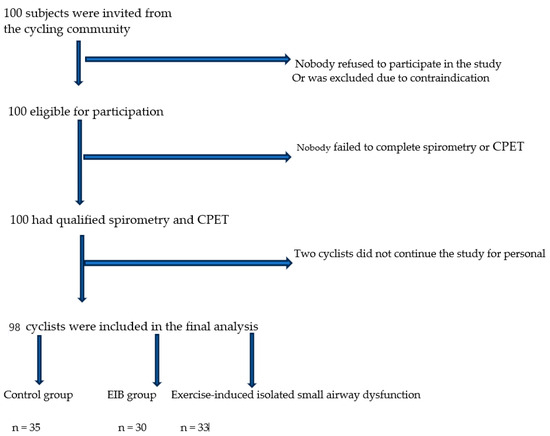Journal Description
Sports
Sports
is an international, peer-reviewed, open access journal published monthly online by MDPI. The Strength and Conditioning Society (SCS), The European Sport Nutrition Society (ESNS) and The European Network of Sport Education (ENSE) are affiliated with Sports and their members receive discounts on the article processing charges.
- Open Access— free for readers, with article processing charges (APC) paid by authors or their institutions.
- High Visibility: indexed within Scopus, ESCI (Web of Science), PubMed, PMC, and other databases.
- Journal Rank: CiteScore - Q1 (Physical Therapy, Sports Therapy and Rehabilitation)
- Rapid Publication: manuscripts are peer-reviewed and a first decision is provided to authors approximately 19.3 days after submission; acceptance to publication is undertaken in 3.7 days (median values for papers published in this journal in the second half of 2023).
- Recognition of Reviewers: reviewers who provide timely, thorough peer-review reports receive vouchers entitling them to a discount on the APC of their next publication in any MDPI journal, in appreciation of the work done.
Impact Factor:
2.7 (2022);
5-Year Impact Factor:
3.3 (2022)
Latest Articles
Impact of Isolated Exercise-Induced Small Airway Dysfunction on Exercise Performance in Professional Male Cyclists
Sports 2024, 12(4), 112; https://doi.org/10.3390/sports12040112 - 19 Apr 2024
Abstract
►
Show Figures
Background: Professional cycling puts significant demands on the respiratory system. Exercise-induced bronchoconstriction (EIB) is a common problem in professional athletes. Small airways may be affected in isolation or in combination with a reduction in forced expiratory volume at the first second (FEV1
[...] Read more.
Background: Professional cycling puts significant demands on the respiratory system. Exercise-induced bronchoconstriction (EIB) is a common problem in professional athletes. Small airways may be affected in isolation or in combination with a reduction in forced expiratory volume at the first second (FEV1). This study aimed to investigate isolated exercise-induced small airway dysfunction (SAD) in professional cyclists and assess the impact of this phenomenon on exercise capacity in this population. Materials and Methods: This research was conducted on professional cyclists with no history of asthma or atopy. Anthropometric characteristics were recorded, the training age was determined, and spirometry and specific markers, such as fractional exhaled nitric oxide (FeNO) and immunoglobulin E (IgE), were measured for all participants. All of the cyclists underwent cardiopulmonary exercise testing (CPET) followed by spirometry. Results: Compared with the controls, 1-FEV3/FVC (the fraction of the FVC that was not expired during the first 3 s of the FVC) was greater in athletes with EIB, but also in those with isolated exercise-induced SAD. The exercise capacity was lower in cyclists with isolated exercise-induced SAD than in the controls, but was similar to that in cyclists with EIB. This phenomenon appeared to be associated with a worse ventilatory reserve (VE/MVV%). Conclusions: According to our data, it appears that professional cyclists may experience no beneficial impacts on their respiratory system. Strenuous endurance exercise can induce airway injury, which is followed by a restorative process. The repeated cycle of injury and repair can trigger the release of pro-inflammatory mediators, the disruption of the airway epithelial barrier, and plasma exudation, which gradually give rise to airway hyper-responsiveness, exercise-induced bronchoconstriction, intrabronchial inflammation, peribronchial fibrosis, and respiratory symptoms. The small airways may be affected in isolation or in combination with a reduction in FEV1. Cyclists with isolated exercise-induced SAD had lower exercise capacity than those in the control group.
Full article
Open AccessSystematic Review
Comparison of the Electromyography Activity during Exercises with Stable and Unstable Surfaces: A Systematic Review and Meta-Analysis
by
Gabriel de Amorim Batista, Sol Patricia Beltrán, Muana Hiandra Pereira dos Passos, Letícia Bojikian Calixtre, Laís Regina de Holanda Santos and Rodrigo Cappato de Araújo
Sports 2024, 12(4), 111; https://doi.org/10.3390/sports12040111 - 18 Apr 2024
Abstract
►▼
Show Figures
The effect of electromyographic (EMG) activity on agonist muscles during exercises performed on stable and unstable surfaces remains uncertain. We aimed to review the literature regarding the comparison of the EMG activity of the agonist muscles of exercises performed on stable and unstable
[...] Read more.
The effect of electromyographic (EMG) activity on agonist muscles during exercises performed on stable and unstable surfaces remains uncertain. We aimed to review the literature regarding the comparison of the EMG activity of the agonist muscles of exercises performed on stable and unstable surfaces. Eighty-six studies that evaluated the EMG activity of 1783 individuals during exercises for the lower limbs, upper limbs, and core were included. The EMG activities of the pectoralis major (SMD = 0.28 [95% CI 0.09, 0.47]) and triceps brachii muscles (SMD = 0.45 [95% CI 0.25, 0.66]) were significantly increased when the unstable device was added to the exercise. Likewise, the EMG activity of all core muscles showed a significant increase with the unstable surface during the exercises, such as the rectus abdominis (SMD = 0.51 [95% CI 0.37, 0.66]), external oblique (SMD = 0.44 [95% CI 0.28, 0.61]), internal oblique (SMD = 1.04 [95% CI 0.02, 2.07]), erector spinae (SMD = 0.37 [95% CI 0.04, 0.71]), and lumbar multifidus (SMD = 0.35 [95% CI 0.08, 0.61]). However, the lower limb muscles did not show greater EMG activity during the exercise with unstable surfaces compared to the stable surface. In conclusion, unstable conditions increase the EMG activity of some upper limb and core muscles compared to a stable surface.
Full article
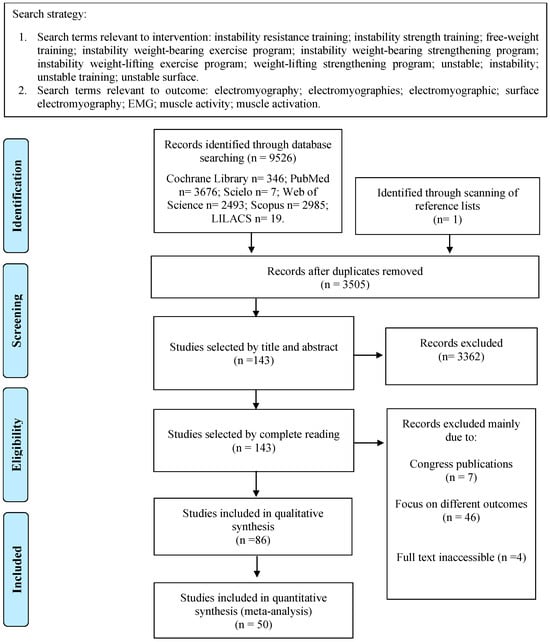
Figure 1
Open AccessArticle
Construction and Validation of Newly Adapted Sport-Specific Anaerobic Diving Tests
by
Ivan Drviš, Dario Vrdoljak, Goran Dujić, Željko Dujić and Nikola Foretić
Sports 2024, 12(4), 110; https://doi.org/10.3390/sports12040110 - 18 Apr 2024
Abstract
►▼
Show Figures
Breath-hold diving is explained as an activity that requires enduring muscle asphyxia and acidosis, high anaerobic capacity, and the tactic of the dive. Therefore, this study aimed to construct and validate tests that will mimic anaerobic processes in the specific media of freedivers.
[...] Read more.
Breath-hold diving is explained as an activity that requires enduring muscle asphyxia and acidosis, high anaerobic capacity, and the tactic of the dive. Therefore, this study aimed to construct and validate tests that will mimic anaerobic processes in the specific media of freedivers. The sample of participants included 34 Croatian freedivers (average age: 26.85 ± 4.0 years, competitive age: 3.82 ± 1.92 years, their body height: 180.14 ± 8.93 cm, and their body mass: 76.82 ± 12.41 kg). The sample of variables consists of anthropometric indices, competitive efficiency (maximal length of a dive (DYN)), and specific anaerobic capacities (100 m and 2 min tests). Newly developed tests included the swimming anaerobic sprint test (SAST) and diving anaerobic sprint test (DAST). DAST and SAST variables included the total time of the test (DAST/SAST) and the fastest interval (DASTmax/SASTmax). The results showed good reliability of the tests with high Cronbach alpha coefficients (DAST: 0.98, DASTmax: 0.97, SAST: 0.99, SASTmax: 0.91). Furthermore, pragmatic validity shows a high correlation among all variables and DAST (DYN: −0.70, 100 m: 0.66, 2 min: −0.68). High relation is also found between 100 m (0.96), 2 min (−0.94), and a moderate result for DYN (−0.43) and the SAST test. A factor analysis extracted one significant factor. The factor analysis involved DAST, SAST, DYN, 100 m, and 2 min tests regarding factor 1. After the examination of all variables, the total time of the DAST test showed the best predictive values for the performance of divers. However, both tests could be used for diagnostics and the evaluation of specific condition abilities in freediving.
Full article
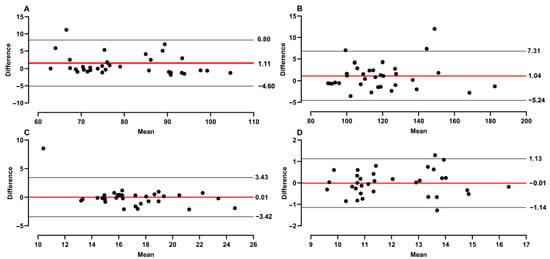
Figure 1
Open AccessArticle
Comparison of Supervised versus Self-Administered Stretching on Bench Press Maximal Strength and Force Development
by
Tim Wohlann, Konstantin Warneke, David G. Behm and Stephan Schiemann
Sports 2024, 12(4), 109; https://doi.org/10.3390/sports12040109 - 17 Apr 2024
Abstract
►▼
Show Figures
Purpose: While there is reported superior effectiveness with supervised training, it usually requires specialized exercise facilities and instructors. It is reported in the literature that high-volume stretching improves pectoralis muscles strength under supervised conditions while practical relevance is discussed. Therefore, the study objective
[...] Read more.
Purpose: While there is reported superior effectiveness with supervised training, it usually requires specialized exercise facilities and instructors. It is reported in the literature that high-volume stretching improves pectoralis muscles strength under supervised conditions while practical relevance is discussed. Therefore, the study objective was to compare the effects of volume equated, supervised- and self-administered home-based stretching on strength performance. Methods: Sixty-three recreational participants were equally assigned to either a supervised static stretching, home-based stretching, or control group. The effects of 15 min pectoralis stretching, 4 days per week for 8 weeks, were assessed on dynamic and isometric bench press strength and force development. Results: While there was a large magnitude maximal strength increase (p < 0.001–0.023, ƞ2 = 0.118–0.351), force development remained unaffected. Dynamic maximal strength in both groups demonstrated large magnitude increases compared to the control group (p < 0.001–0.001, d = 1.227–0.905). No differences between the intervention group for maximal strength (p = 0.518–0.821, d = 0.101–0.322) could be detected. Conclusions: The results could potentially be attributed to stretch-induced tension (mechanical overload) with subsequent anabolic adaptations, and alternative explanatory approaches are discussed. Nevertheless, home-based stretching seems a practical alternative to supervised training with potential meaningful applications in different settings.
Full article
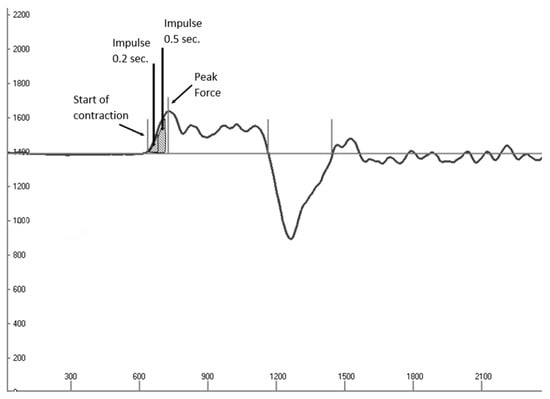
Figure 1
Open AccessArticle
Effect of Verbal Encouragement on Performance and Affective Responses in Male Sport Science Students during Sprint Modalities
by
Faten Sahli, Nidhal Jebabli, Okba Selmi, Manar Boujabli, Hajer Sahli, Makram Zghibi and Monoem Haddad
Sports 2024, 12(4), 108; https://doi.org/10.3390/sports12040108 - 15 Apr 2024
Abstract
This investigation aimed to examine the effect of verbal encouragement teacher to student (VETS) versus verbal encouragement student to student (VESS) on physical performance and affective responses during different modalities of sprint tests in active male students. In a randomized crossover design, twenty-two
[...] Read more.
This investigation aimed to examine the effect of verbal encouragement teacher to student (VETS) versus verbal encouragement student to student (VESS) on physical performance and affective responses during different modalities of sprint tests in active male students. In a randomized crossover design, twenty-two male sport science students (age: 21 ± 1.2 years, body height: 1.77 ± 0.3 m, body mass: 76.6 ± 2.1 kg, BMI: 22.9 ± 1.3 kg·m−2) performed linear and change-of-direction sprint tests under one of three conditions: (1) VETS; (2) VETS; (3) no verbal encouragement. In each condition, participants performed the 20 m sprint test, the 10 × 2 sprint test, and the L sprint test. The assessed parameters comprised physical performance, rating of perceived exertion (RPE), and a feeling scale. Post hoc test analysis indicates a significant increase in physical performance during VETS and VESS conditions compared to the control condition due to a decrease in sprint in line 20 m (VETS: p < 0.001, d = 0.55; VESS: p = 0.016, d = 0.41), sprint 10*2 (VETS: p < 0.001, d = 0.64; VESS: p = 0.05, d = 0.36), and sprint L (VETS: p = 0.001, d = 1.19) times compared to the control condition. Moreover, the feeling score was greater after VETS compared to other conditions (p = [<0.001–0.001], d = [0.77–1.18]). In addition, the RPE had no effect on sprint performance between the different conditions. It is indicated that VETS, rather than VESS, is a more significant and effective way to increase effort intensity and positive feelings during sprinting modalities.
Full article
(This article belongs to the Special Issue Advances in Sport Psychology)
►▼
Show Figures
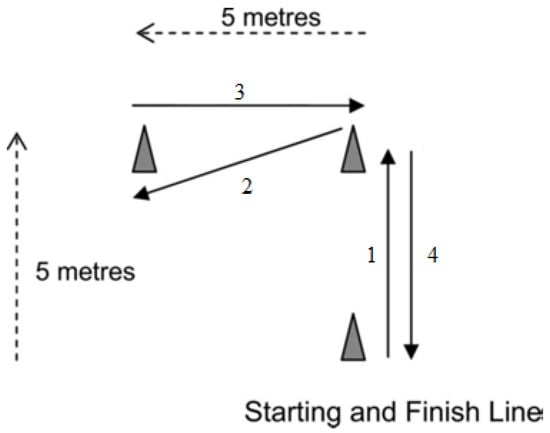
Figure 1
Open AccessArticle
Stroke Steadiness as a Determinant Factor of Performance in 100 m Freestyle in Young Swimmers
by
Daniel López-Plaza, Carmen Daniela Quero-Calero, Fernando Alacid and Oriol Abellán-Aynés
Sports 2024, 12(4), 107; https://doi.org/10.3390/sports12040107 - 12 Apr 2024
Abstract
The classical kinematic variables in swimming are based on the calculation of mean values. Stroke steadiness determines the relationship between the duration of all consecutive strokes throughout a test. The aims of the current investigation were to examine differences in stroke-to-stroke steadiness according
[...] Read more.
The classical kinematic variables in swimming are based on the calculation of mean values. Stroke steadiness determines the relationship between the duration of all consecutive strokes throughout a test. The aims of the current investigation were to examine differences in stroke-to-stroke steadiness according to swimmers’ performance level on both body sides (breathing and non-breathing) and to analyse the interrelationship with kinematics during a 100 m front-crawl test. Thirty-two young, experienced swimmers voluntarily participated in the present study and were divided into two groups, national level (n = 15) and local level (n = 17), according to their competitive status within the national age-rankings. All participants performed a 100 m maximal test in a 50 m pool where they were laterally recorded. Kinematic variables such as mean velocity, stroke rate, stroke length, and stroke index, as well as long-term steadiness and short-term steadiness, were calculated. The two 50 m sections were analysed independently. Significant differences were observed between the two groups in the classical kinematic variables and in stroke steadiness (p < 0.05). In addition, stroke steadiness showed moderately high correlations with velocity (r = [−0.61–(−0.749)]) and stroke index (r = [−0.356–(−0.582)]). Maintaining a more stable inter-stroke period appears to be a determinant of performance in young, high-level national swimmers.
Full article
Open AccessArticle
Mental Health in First- and Second-Division Soccer Players: A Cross-Sectional Study
by
Lucía Bonet, Ana Benito, Héctor Usó, Marc Peraire, Gonzalo Haro and Isabel Almodóvar-Fernández
Sports 2024, 12(4), 106; https://doi.org/10.3390/sports12040106 - 11 Apr 2024
Abstract
Background: The benefits of sport in mental health have been broadly studied. However, few studies have examined these outcomes in high-performance athletes. We aimed to analyze the state of the mental health of the Villarreal Soccer Club’s first- (FD) and second-division (SD) players
[...] Read more.
Background: The benefits of sport in mental health have been broadly studied. However, few studies have examined these outcomes in high-performance athletes. We aimed to analyze the state of the mental health of the Villarreal Soccer Club’s first- (FD) and second-division (SD) players and the possible mediating effects of sex and professional category. Methods: This was a cross-sectional study with an initial sample of 108 soccer players (final sample n = 54). Data from MINI, HARS, HDRS, BARRAT-11 and SCSRQ questionnaires were analyzed. Results: The mean age was 23.41 years (SD = 4.56) and 61.1% (n = 33) were men. A proportion of 24.1% (n = 13) stated that they had undergone mental health treatment, 7.4% (n = 4) had taken psychotropic drugs, and 2.1% (n = 1) had made a suicide attempt. Differences were observed between the FD and SD players in terms of the sensitivity to punishment (t = −2.2; p = 0.033), overall impulsivity (t = −3.1; p = 0.003), unplanned impulsivity (t = 3.4; p = 0.001), and the HDRS (U = −110.5; p = 0.004), HARS-Total (U = −104.0; p = 0.006) and HARS-Psychological subscale scores (U = −104.0; p = 0.001). Differences were also observed between the female and male SD players for the HARS-Somatic subscale (U = 136.5; p = 0.028). Conclusion: The low values obtained in the clinical scales, together with the reported psychopathological histories, suggested that the Villareal players showed better mental health than the general population.
Full article
Open AccessArticle
The Impact of a 12-Week Aqua Fitness Program on the Physical Fitness of Women over 60 Years of Age
by
Katarzyna Kucia, Agnieszka Koteja, Łukasz Rydzik, Norollah Javdaneh, Arash Shams and Tadeusz Ambroży
Sports 2024, 12(4), 105; https://doi.org/10.3390/sports12040105 - 11 Apr 2024
Abstract
►▼
Show Figures
Background: This study aimed to assess the impact of a 12-week Aqua Fitness program on the physical fitness of older women and emphasize sustainable health practices for aging populations. We focused on evaluating the program’s effectiveness, using the Senior Fitness Test to measure
[...] Read more.
Background: This study aimed to assess the impact of a 12-week Aqua Fitness program on the physical fitness of older women and emphasize sustainable health practices for aging populations. We focused on evaluating the program’s effectiveness, using the Senior Fitness Test to measure improvements in physical capabilities. Methods: An experimental research design was implemented, with 30 participants aged 60 and older. The participants were divided into a control group and an experimental group, each comprising 15 individuals. The control group received aqua Fitness exercises, and the experimental group received aqua fitness exercises and isometric (combined) exercises. Lower limb muscle strength, upper limb muscle strength, lower body flexibility, upper body flexibility, dynamic balance, agility, and endurance were assessed using the Senior Fitness Test. Assessments were conducted pre- and post-training. Results: For a comparison within the group, combined exercises (aqua fitness and isometric exercises) had a significant effect on lower limb muscle strength, upper limb muscle strength, lower body flexibility, upper body flexibility on the right side, dynamic balance, agility, and endurance. Aqua fitness exercises alone showed significant effects on upper limb muscle strength, lower body flexibility, and endurance and no significant effects on other variables. For the comparison between groups, no significant differences were found between the effects of aqua fitness exercises and combined exercises on lower limb muscle strength, upper limb muscle strength, lower body flexibility, upper body flexibility, and endurance. Significant differences were found only in dynamic balance and agility between the two groups of aqua fitness and combined exercises. Conclusions: Although the combined program (aqua fitness and isometric exercises) had a greater effect on improving the physical fitness of older adults than aqua fitness alone, there was no significant difference between the two groups. Therefore, the results of this study highlight the potential of aqua fitness in promoting sustainable health and physical fitness in the older adult population.
Full article
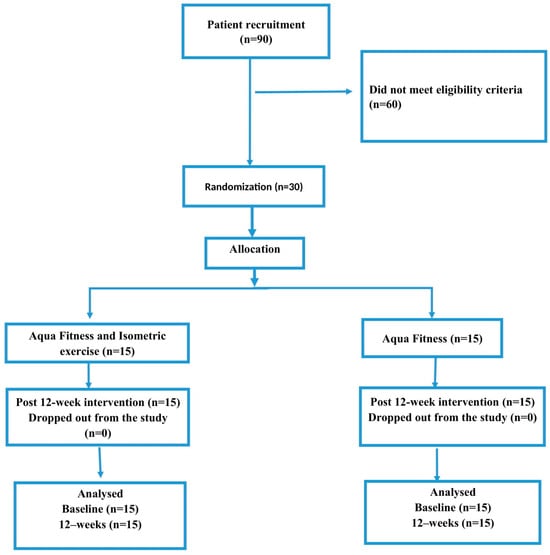
Figure 1
Open AccessArticle
Dryland Performance Tests Are Not Good Predictors of World Aquatics Points in Elite Male and Female Swimmers
by
Ragul Selvamoorthy, Lewis J. Macgregor, Neil Donald and Angus M. Hunter
Sports 2024, 12(4), 104; https://doi.org/10.3390/sports12040104 - 10 Apr 2024
Abstract
Background: Swim performance can be reliant on strength and power. Standardisation of swim performance in different events, distances, and sexes can be completed using World Aquatics points, allowing for ranking of swimmers. The aim of this retrospective cross-sectional study was to assess whether
[...] Read more.
Background: Swim performance can be reliant on strength and power. Standardisation of swim performance in different events, distances, and sexes can be completed using World Aquatics points, allowing for ranking of swimmers. The aim of this retrospective cross-sectional study was to assess whether relationships between World Aquatics points and dryland markers of performance existed in male and female elite swimmers separately and combined. Methods: Dryland tests included Optojump® photoelectric cell countermovement jump, countermovement jump reach with a Vertec® system, standing broad jump using a tape measure, repetition maximum testing in the barbell back squat, barbell deadlift, and barbell bench press. Swim performance data and dryland test data on elite male (n = 38) and female (n = 20) Scottish swimmers from 2009–2017 were collected. Swim performance data were converted to World Aquatics federation points, and Bayesian linear regression analyses examined relationships between World Aquatics points and dryland performance tests: countermovement jump height (cm) using an Optojump® photoelectric cells system, countermovement jump height (cm) using a Vertec® device, standing broad jump distance (cm), relative strength (load lifted (kg) per kg of body mass) in the barbell bench press (kg/kg), barbell back squat (kg/kg), barbell deadlift (kg/kg). Results: The Bayesian estimates of change of World Aquatics points for a unit change in jump-based measures were: Optojump®—men = 0.6, women = 0.6, combined = 0.4; Vertec®—men = 4.3, women = −1.6, combined = 2.4; standing broad jump—men = 0, women = −0, combined = 0.4. Strength-based measures were: barbell back squat—men = 2.3, women = 22, combined = −2.5; barbell deadlift—men = −5; barbell bench press—men = 41.8. Conclusions: Dryland performance tests are not good predictors of World Aquatics points and should rather be used for assessing training quality and monitoring injury risks.
Full article
Open AccessArticle
Birth Advantages in Male Italian Soccer: How They Influence Players Youth Career and Their Future Career Status
by
Gabriele Morganti, Paolo Riccardo Brustio, Bruno Ruscello, Gennaro Apollaro, Elvira Padua and Adam L. Kelly
Sports 2024, 12(4), 103; https://doi.org/10.3390/sports12040103 - 09 Apr 2024
Abstract
►▼
Show Figures
Soccer organizations generally adopt deterministic models within their talent pathways. In this framework, early ability and results are emphasized, leading to selection biases, such as birth advantages (i.e., relative age effects and birthplace effects), which research has shown affect both early developmental experiences
[...] Read more.
Soccer organizations generally adopt deterministic models within their talent pathways. In this framework, early ability and results are emphasized, leading to selection biases, such as birth advantages (i.e., relative age effects and birthplace effects), which research has shown affect both early developmental experiences and continued sporting involvement. Accordingly, this study aimed to (a) provide further test of birth advantages in Italian youth soccer by exploring the birth quarter (BQ) and birthplace (BP) distribution of 1050 male Italian players born between 1999 and 2001 who competed in the national U17 championship throughout the 2015–16 season and (b) investigate how birth advantages influenced selected players’ future career status. Chi-square goodness-of-fit tests revealed early born players, and players born in North Italy were overrepresented at the youth level (p-values < 0.0001). Successive prospective analysis revealed only 18% of players developed into professional-level soccer players. Chi-square tests of independence indicated that players’ BP was associated with their future career status (p < 0.0001), whereas their BQ was not (p = 0.459). Odds ratios showed players born in North Italy were five times more likely to complete the youth-to-senior transition than those born in South Italy. These findings highlighted environmental factors influence Italian players’ early developmental experiences and their future career status.
Full article

Figure 1
Open AccessArticle
The Acute Effects of Ball Pressure on Anticipation Timing Following a Series of Purposeful Headers in Adult Football (Soccer) Players
by
Chad McLean, Andrew P. Lavender, Ethan Pereira, Kerry Peek, Paul Davey, Fadi Ma’ayah, Susan Morris and Julia Georgieva
Sports 2024, 12(4), 102; https://doi.org/10.3390/sports12040102 - 02 Apr 2024
Abstract
►▼
Show Figures
The purpose of this study is to investigate the acute effects of ball pressure on anticipation timing following a series of purposeful headers in adult football (soccer) players. There is evidence to suggest acute neurophysiological changes to the brain following purposeful heading; this
[...] Read more.
The purpose of this study is to investigate the acute effects of ball pressure on anticipation timing following a series of purposeful headers in adult football (soccer) players. There is evidence to suggest acute neurophysiological changes to the brain following purposeful heading; this may lead to altered anticipation timing as a result, potentially having future safety implications for players. A repeated measures crossover design was used. Seventeen participants aged between 20 and 30 years performed (i) 20 rotational headers with a lower-pressure match ball (58.6 kPa; 8.5 psi), (ii) 20 rotational headers with a higher-pressure match ball (103.4 kPa; 15 psi), or (iii) 20 non-headers (kicks) as a control each on separate days. The effect of ball pressure on anticipation timing accuracy, measured as absolute, constant, and variable errors, was assessed before and immediately after each intervention session using an anticipation timing task. Differences between group means were compared using repeated measures ANOVA and linear mixed effects models, with p-values of <0.05 considered statistically significant. No significant differences in anticipation timing accuracy across interventions were detected between control, occluded, and non-occluded trials. This finding differs from the previous literature regarding the measurable, acute effects of purposeful heading. The anticipation timing task may lack sensitivity for detecting the effects of repeated heading on brain function.
Full article

Figure 1
Open AccessArticle
Injuries and Persistent Pain in Elite Adolescent Archery Athletes: A Cross-Sectional Epidemiological Study
by
Nikolaos Vasilis, Athanasios Kyriakides, George Vasilopoulos, Maria Chatzitimotheou, Grigorios Gonidakis, Athanasios Kotsakis, Eleftherios Paraskevopoulos and Eleni Kapreli
Sports 2024, 12(4), 101; https://doi.org/10.3390/sports12040101 - 02 Apr 2024
Abstract
This cross-sectional epidemiological study aimed to evaluate the prevalence of injuries among young archers engaged in high-intensity training during the European Youth Championship. A total of 200 participants (104 males/96 females) from 34 countries were included, with a mean age of 16.9 years
[...] Read more.
This cross-sectional epidemiological study aimed to evaluate the prevalence of injuries among young archers engaged in high-intensity training during the European Youth Championship. A total of 200 participants (104 males/96 females) from 34 countries were included, with a mean age of 16.9 years and average competitive experience of 6.5 years. Structured questionnaires, administered by four physiotherapist interviewers, gathered comprehensive data. Results revealed that 43.5% of participants experienced shoulder pain during training, highlighting the vulnerability of upper limbs in archers. Additionally, 30% required medications to facilitate training, underscoring the impact of injuries on continued participation. Physiotherapy was utilized by 52.3% of participants, emphasizing the need for therapeutic intervention. Furthermore, 31.8% had to cease training due to injuries, indicating a substantial hindrance to athletic progression. The mean pain duration was 3.9 months, with an average intensity of 5.94, and 8% exhibited symptoms of central sensitization. In conclusion, this study demonstrates a noteworthy prevalence of injuries, particularly in the upper limbs, among young archers undergoing intensive training. The findings underscore the importance of targeted injury prevention strategies and comprehensive rehabilitation approaches to ensure the well-being and sustained participation of young athletes in competitive archery.
Full article
(This article belongs to the Special Issue Advances in Sports Medicine: Exercise and Training for Injury Prevention)
►▼
Show Figures
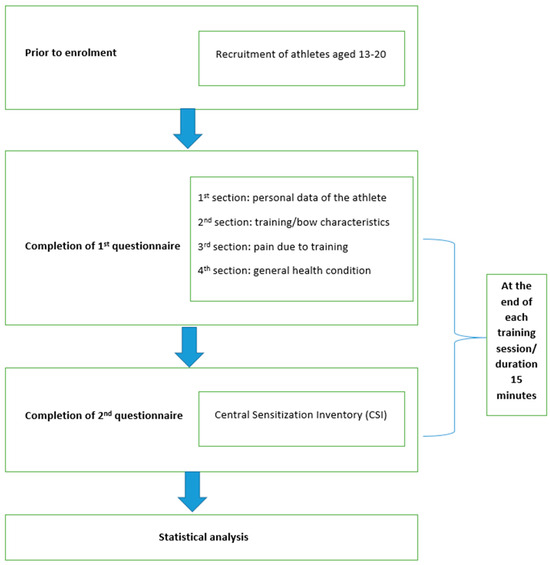
Figure 1
Open AccessArticle
Perceived Coach-Created Empowering and Disempowering Climate Effects on Athletes’ Intentions to Use Doping: The Mediational Role of Self-Regulatory Efficacy and Attitudes towards Doping
by
Beatrice Hoppen and Saulius Sukys
Sports 2024, 12(4), 100; https://doi.org/10.3390/sports12040100 - 01 Apr 2024
Abstract
Background: The purpose of this study was to examine the relationship between perceived coach-created empowering and disempowering motivational climate and doping likelihood among athletes and whether the attitudes towards doping and doping self-regulatory efficacy mediates these relationships. Methods: Athletes (N = 948; 50%
[...] Read more.
Background: The purpose of this study was to examine the relationship between perceived coach-created empowering and disempowering motivational climate and doping likelihood among athletes and whether the attitudes towards doping and doping self-regulatory efficacy mediates these relationships. Methods: Athletes (N = 948; 50% male; mean age, 20.32, SD = 2.45) recruited from a variety of sports completed questionnaires assessing their perceptions of coach-created motivational climate, attitudes towards doping, doping self-regulatory efficacy, and doping likelihood. Results: The study’s results showed significant negative direct effects of a perceived empowering climate on doping likelihood (β = −0.50) and attitudes towards doping (β = −0.48), and a positive effect on self-regulatory efficacy (β = 0.48). On the contrary, a disempowering climate had positive direct effects on doping likelihood (β = 0.53) and attitudes towards doping (β = 0.45), and a negative effect on self-regulatory efficacy (β = −0.49). Significant indirect effects on doping likelihood via attitudes and self-regulatory efficacy were found. Conclusions: Our findings suggest that athletes who perceive a more empowering climate created by the coach are less likely to use banned substances due to their more negative attitudes towards doping and stronger belief in their ability to resist the temptation to use doping.
Full article
(This article belongs to the Special Issue Advances in Sport Psychology)
►▼
Show Figures
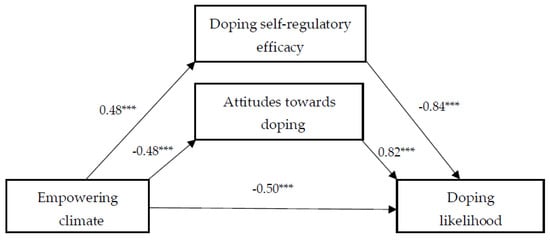
Figure 1
Open AccessArticle
Place Matters: A Study on the Influence of Birthplace and the Place of Development on Soccer Academy Players’ Careers
by
Lander Hernández-Simal, Julio Calleja-González, Jon Larruskain, Alberto Lorenzo Calvo and Maite Aurrekoetxea-Casaus
Sports 2024, 12(4), 99; https://doi.org/10.3390/sports12040099 - 31 Mar 2024
Abstract
►▼
Show Figures
The effect of birthplace (the place where a player is born and grows up) is one of the key variables associated with soccer player development and achievement. However, recent studies have questioned the influence of contextual variables on selection and promotion processes related
[...] Read more.
The effect of birthplace (the place where a player is born and grows up) is one of the key variables associated with soccer player development and achievement. However, recent studies have questioned the influence of contextual variables on selection and promotion processes related to birthplace. The main purposes of this study were: (1) establish whether there is a difference between the birthplace and sporting growth according to the stages of entry into the academy, (2) to evaluate the influence of geographical and contextual variables on sporting development, and (3) assess the chances of making a professional team debut. Applied logistic regression was used in order to analyse the birthplace and growth of 1411 male soccer players, of which 40.1% are incorporated in the U-12 category from a Spanish First division club, and the results showed a statistically significant association between a change from one’s birthplace to the place of sporting growth and later success (79%). Key contextual variables such as number of inhabitants, population density, proximity to sports facilities, average household income and presence of sports clubs have been considered. The analysis of the contextual variables revealed that there was a positive relationship between certain variables, like a higher population, and being selected for the academy (p < 0.01; r = 0.28). Finally, the findings showed that players who experienced a geographical transition were 38% more likely to make a professional debut. The importance of considering the place of sporting growth when analysing the “birthplace effect” has therefore been demonstrated.
Full article

Figure 1
Open AccessArticle
Determining Factors Influencing Collegiate Players’ Intention to Pursue a Professional Career
by
Mathew Gerald D. C. Lebria, Cymond R. Ochoa, Jasmin Marie P. Tionloc, Ardvin Kester S. Ong and Josephine D. German
Sports 2024, 12(4), 98; https://doi.org/10.3390/sports12040098 - 30 Mar 2024
Abstract
The rise of professional careers in playing sports has been seen in the recent generation. Ranging from traditional sports to recent e-games, it can be seen that student athletes are not only considering these as motivational factors for education, but also as future
[...] Read more.
The rise of professional careers in playing sports has been seen in the recent generation. Ranging from traditional sports to recent e-games, it can be seen that student athletes are not only considering these as motivational factors for education, but also as future career paths. This study aims to fill the knowledge gap about the factors influencing college athletes’ aspirations to play professionally. The study examines the complex web of athlete decision-making by utilizing the extended Theory of Planned Behavior (TPB) and analyzing the roles of motivational factors, self-efficacy, affective behavior, and behavioral domains. With the use of structural equation modeling, the study deciphers the intricate links, emphasizing the critical role that attitude plays in affective behavior. It emphasizes how much optimism and self-efficacy shape an athlete’s behavior and subsequent pursuit of professional careers. The current research provides a benchmark for future studies exploring student athletes’ career goals. This research adds understanding to the knowledge gap regarding the complex decision-making procedures of aspiring professional athletes. Both theoretical and practical implications are provided based on the results of the study, which stakeholders and institutions may consider for student athletes wanting to pursue a professional sports career.
Full article
(This article belongs to the Special Issue Second Edition: Sport Psychology Interventions for Athletes' Performance and Well-Being)
►▼
Show Figures
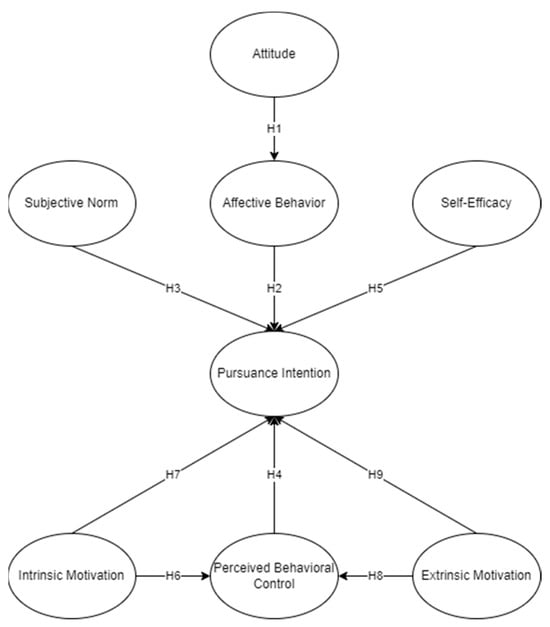
Figure 1
Open AccessArticle
Neuromuscular Fitness Is Associated with Serve Speed in Young Female Tennis Players
by
Zlatan Bilić, Paola Martić, Petar Barbaros, Filip Sinković and Dario Novak
Sports 2024, 12(4), 97; https://doi.org/10.3390/sports12040097 - 30 Mar 2024
Abstract
In tennis, the serve plays a key role in determining the success of a player. The speed of a serve is influenced by a multitude of interconnected skills and abilities. The objective of this study was to establish the correlation between the explosive
[...] Read more.
In tennis, the serve plays a key role in determining the success of a player. The speed of a serve is influenced by a multitude of interconnected skills and abilities. The objective of this study was to establish the correlation between the explosive strength of the throwing type, the grip strength and flexibility of the arms, and the shoulder girdle with the serve speed in young female tennis players. Additionally, the study aimed to develop a regression model that accurately predicts the serve speed by analyzing the interplay among these variables. The study was carried out on a group of 20 tennis players, who had an average age of 13.10 ± 0.74 years. Additionally, their height was recorded as 165.70 ± 4.90 cm, and their body mass was measured at 51.45 ± 5.84 kg. To assess the motor abilities of the upper extremities, four tests were used that aimed to measure the explosive strength of the throwing type; one test was for the strength of the hand and forearm muscles, and one test was for the flexibility of the arms and shoulder girdle. Of all the variables examined, the medicine ball throw shot put (MBTSP) (r = 0.75), overhead medicine ball throw (OMBT) (r = 0.70), and grip strength (GS) (r = 0.71) displayed a notable correlation with serve speed (p < 0.05). The results obtained from the multiple regression analysis indicate that the combination of selected predictors (MBTSP—medicine ball throw shot put, OMBT—overhead medicine ball throw and GS—grip strength) explained 75% of the variability in serve speed. Significantly, MBTSP surfaced as the predominant predictor, autonomously elucidating 51% of the variability in serve speed. The importance of improving the analyzed motor skills of young female tennis players to enhance their serve in terms of speed is emphasized by the findings of this research.
Full article
(This article belongs to the Special Issue Effect of Neuromuscular Fatigue Mechanisms on Exercise Performance)
Open AccessArticle
Investigation of Factors Related to Sport-Specific Compulsory Element Execution in Artistic Swimming
by
Vivien Laski, Dóra Ureczky and Márta Wilhelm
Sports 2024, 12(4), 96; https://doi.org/10.3390/sports12040096 - 30 Mar 2024
Abstract
Artistic swimming is an Olympic sport requiring a high level of fitness, as well as technical skills, artistry, flexibility, a good sense of rhythm, remarkable lung capacity and physical strength. The artistic swimming of adolescents has been largely untouched by the scientific community,
[...] Read more.
Artistic swimming is an Olympic sport requiring a high level of fitness, as well as technical skills, artistry, flexibility, a good sense of rhythm, remarkable lung capacity and physical strength. The artistic swimming of adolescents has been largely untouched by the scientific community, so training this group based on scientific data is difficult. Due to the gap between theoretical knowledge and practical application, this study aimed to measure the technical elements, strength parameters, and swimming performance of young artistic swimmers and to compare swimming performance and strength with the quality of artistic element performances. Hungarian female junior artistic swimmers (14.36 ± 1.01 year) participated in this study. Swimming tests were performed, and three basic elements (body boost, barracuda, and vertical position) were scored. A negative correlation was found between 100 m freestyle swimming times and vertical position scores, as well as between 50 m breaststroke leg swimming times and body boost scores. Moreover, three months of breaststroke leg swim training resulted in improvements in body boost performance. In addition, a positive correlation was found between mean hand grip strength and barracuda scores, as well as between vertical position scores. According to the results of three months of breaststroke leg training, swimming practice improves artistic swimming performance by itself. A correlation was found between strength parameters and the execution of synchro elements, showing the importance of complex training strategies in this sport.
Full article
Open AccessArticle
Force Production and Electromyographic Activity during Different Flywheel Deadlift Exercises
by
Sergio Maroto-Izquierdo, David García-López, Marco Beato, Iker J. Bautista, José L. Hernández-Davó, Javier Raya-González and Fernando Martín-Rivera
Sports 2024, 12(4), 95; https://doi.org/10.3390/sports12040095 - 29 Mar 2024
Abstract
This study aimed to characterize and compare force production and muscle activity during four flywheel deadlift exercises (bilateral [Bi] vs. unilateral [Uni]) with different loading conditions (vertical [Ver] vs. horizontal [Hor]). Twenty-three team-sport athletes underwent assessments for exercise kinetics (hand-grip force), along with
[...] Read more.
This study aimed to characterize and compare force production and muscle activity during four flywheel deadlift exercises (bilateral [Bi] vs. unilateral [Uni]) with different loading conditions (vertical [Ver] vs. horizontal [Hor]). Twenty-three team-sport athletes underwent assessments for exercise kinetics (hand-grip force), along with surface electromyography (sEMG) of the proximal (BFProx) and medial biceps femoris (BFMed), semitendinosus (ST), and gluteus medius (GM). Mean and peak force were highest (p < 0.001) in Bi + Ver compared with Bi + Hor, Uni + Ver, and Uni + Hor. Although no significant differences were observed between Bi + Hor and Uni + Ver, both variants showed higher (p < 0.001) average force and peak eccentric force when compared with Uni + Hor. The presence of eccentric overload was only observed in the vertically loaded variants. Bi + Ver and Uni + Ver showed higher (p < 0.05) sEMG levels in BFProx and BFMed compared with the Uni + Hor variant. In addition, Uni + Ver registered the largest GM and ST sEMG values. In conclusion, the vertical variants of the flywheel deadlift exercise led to higher muscle force production and sEMG compared with their horizontal counterparts. Both Bi + Ver and Uni + Ver may be effective in promoting an increase in hamstring muscles activity and muscle force at long muscle length, while the Uni + Ver variant may be more effective in promoting GM and ST involvement.
Full article
(This article belongs to the Special Issue Strength and Conditioning Society 2023: Sports Performance, Injury Prevention, Rehabilitation, and Health Improvement)
►▼
Show Figures
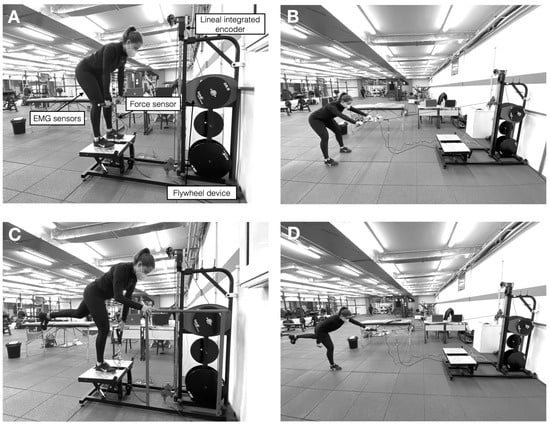
Figure 1
Open AccessArticle
Are Dryland Strength and Power Measurements Associated with Swimming Performance? Preliminary Results on Elite Paralympic Swimmers
by
Luca Cavaggioni, Raffaele Scurati, Massimiliano Tosin, Riccardo Vernole, Luca Bonfanti, Athos Trecroci and Damiano Formenti
Sports 2024, 12(4), 94; https://doi.org/10.3390/sports12040094 - 26 Mar 2024
Abstract
►▼
Show Figures
This study aimed to identify the relationship between dryland tests and swimming performance in elite Paralympic swimmers. Fifteen competitive swimmers (age: 27.4 ± 5.4 years, height: 1.70 ± 6.8 m, body mass: 67.9 ± 9.2 kg; 9 males, 6 females) performed a lat
[...] Read more.
This study aimed to identify the relationship between dryland tests and swimming performance in elite Paralympic swimmers. Fifteen competitive swimmers (age: 27.4 ± 5.4 years, height: 1.70 ± 6.8 m, body mass: 67.9 ± 9.2 kg; 9 males, 6 females) performed a lat pull-down and a bench press incremental load test to determine maximum power (Pmax), the strength corresponding to maximum power (F@Pmax), and the barbell velocity corresponding to maximum power (V@Pmax) from the force–velocity and power–velocity profiles. These outcomes were also normalized by the athlete’s body mass. Swimming performance was carried out from the best result in a 100 m freestyle race registered during an international competition. Lat pull-down F@Pmax was significantly associated with 100 m freestyle chronometric time (ρ = −0.56, p < 0.05), and lat pull-down V@Pmax presented a relationship with mean swimming velocity (ρ = 0.71, p < 0.01). Similarly, bench press F@Pmax and the normalized F@Pmax were significantly related to the mean swimming velocity (ρ = −0.51, ρ = −0.62, p < 0.05). Stepwise multiple regression showed that lat pull-down V@Pmax, bench press normF@Pmax, and V@Pmax accounted for 40.6%, 42.3%, and 65.8% (p < 0.05) of the mean swimming velocity variance. These preliminary results highlighted that simple dryland tests, although with a moderate relationship, are significantly associated with 100 m freestyle swimming performance in elite Paralympic swimmers.
Full article
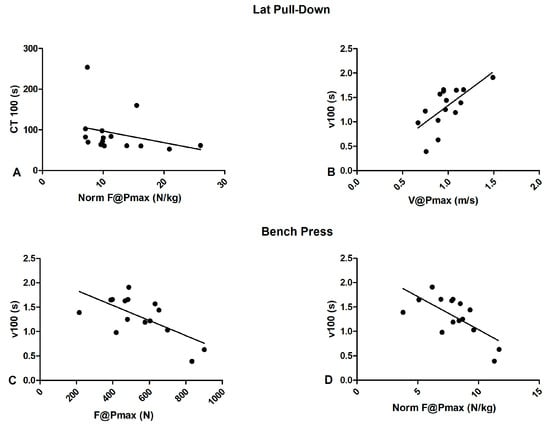
Figure 1
Open AccessArticle
Accuracy of the SenseWear Armband during Short Bouts of Exercise
by
Ryan D. Wedge, Mike McCammon and Stacey A. Meardon
Sports 2024, 12(4), 93; https://doi.org/10.3390/sports12040093 - 26 Mar 2024
Abstract
►▼
Show Figures
A goal of mobile monitoring is to approximate metabolic energy expenditure (EE) during activities of daily living and exercise. Many physical activity monitors are inaccurate with respect to estimated EE and differentiating between activities that occur over short intervals. The objective of our
[...] Read more.
A goal of mobile monitoring is to approximate metabolic energy expenditure (EE) during activities of daily living and exercise. Many physical activity monitors are inaccurate with respect to estimated EE and differentiating between activities that occur over short intervals. The objective of our study was to assess the validity of the SenseWear Armband (SWA) compared to indirect calorimetry (IC) during short intervals of walking and running. Twenty young, fit participants walked (preferred speed) and ran (75%, 85%, and 95% of predicted VO2max run speeds) on a treadmill. EE estimates from IC, SWA, and prediction equations that used the SWA, speed, and heart rate were examined during each 4 min interval and across the whole protocol (Total). The level of significance was p < 0.05. The SWA overestimated EE relative to IC by 1.62 kcal·min−1 while walking and 1.05 kcal·min−1 while running at 75%. However, it underestimated EE at the 85% (0.05 kcal·min−1) and 95% (0.92 kcal·min−1) speeds, but not significantly, and overestimated total EE by 28.29 kcal. Except for walking, our results suggest that the SWA displayed a good level of agreement (ICC = 0.76 to 0.84) with IC measures. Activity-specific algorithms using SWA, speed, and heart rate improved EE estimates, based on the standard error of the estimates, but perhaps not enough to justify extra sensors. The SWA may enable EE estimation of locomotion outside the laboratory, including those with short bouts of high intensity activity, but continued development of the SWA, or devices like it, is needed to enable accurate monitoring.
Full article
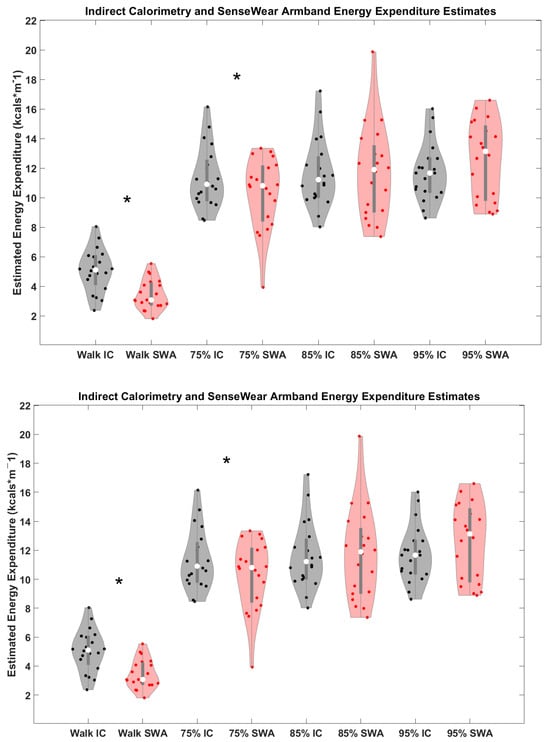
Figure 1
Highly Accessed Articles
Latest Books
E-Mail Alert
News
Topics
Topic in
Societies, Sports, Healthcare
Sport and Society
Topic Editors: José Carmelo Adsuar, Mitchell Alberto Alarcón Diaz, Jorge Carlos-Vivas, Roxana Paola Palacios Cartagena, Carmen Galán Arroyo, Ana Fondón-LudeñaDeadline: 31 July 2024
Topic in
Behavioral Sciences, EJIHPE, JFMK, Sports, Sustainability
Interdisciplinary Approaches to Sports in the 21st Century
Topic Editors: Paweł A. Piepiora, Zbigniew Norbert PiepioraDeadline: 31 December 2024
Topic in
Healthcare, Hygiene, JCM, Life, Sports
Physical Exercise Impacts on Human Physical and Psychological Health
Topic Editors: Xueqiang Wang, Li Li, Li HuDeadline: 30 June 2025
Topic in
Biomechanics, Healthcare, IJERPH, Nutrients, Sports, Sensors, Muscles, Foods
Endurance and Ultra-Endurance: Implications of Training, Recovery, Nutrition, and Technology on Performance and Health
Topic Editors: Nicolas Berger, Russ BestDeadline: 31 December 2025

Conferences
Special Issues
Special Issue in
Sports
The Potential Role of Artificial Intelligence in Sports Cardiology
Guest Editors: Stefano Palermi, Marco Vecchiato, Andrea SagliettoDeadline: 20 April 2024
Special Issue in
Sports
Second Edition: Sport Psychology Interventions for Athletes' Performance and Well-Being
Guest Editor: Selenia Di FronsoDeadline: 30 April 2024
Special Issue in
Sports
Sport Physiology and Physical Performance
Guest Editors: Ryland Morgans, Dave RhodesDeadline: 20 May 2024
Special Issue in
Sports
Maintaining a Healthy Lifestyle: Sustainability of Promoting Physical Activity
Guest Editors: Wenfei Zhu, Yuliang SunDeadline: 31 May 2024




